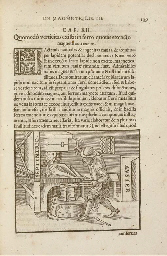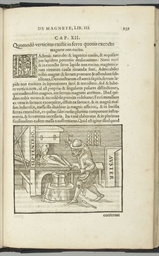GILBERT, William (1544-1603). De magnete, magneticisque corporibus, et de magno magnete tellure; Physiologia nova, plurimis & argumentis, & experimentis demonstrata . London: Peter Short, 1600.
GILBERT, William (1544-1603). De magnete, magneticisque corporibus, et de magno magnete tellure; Physiologia nova, plurimis & argumentis, & experimentis demonstrata . London: Peter Short, 1600. 2° (276 x 181mm). Woodcut title device and large woodcut arms on verso, one folding plate, numerous woodcuts in text, some full-page. (Some spotting, a short marginal tear to plate.) 20th-century calf to style, spine lettered in gilt, the sides centred with an arabesque in blind. Provenance : a leaf of notes in contemporary manuscript bound in; a few marginal notes in a neat hand. FIRST EDITION. THE FIRST GREAT SCIENTIFIC BOOK TO BE PRINTED IN ENGLAND . 'Gilbert coined the terms "electricity", "electric force" and "electric attraction" and may rightly be considered the founder of electrical science' (PMM); further, he 'provided the only fully developed theory dealing with all five of the then known magnetic movements and the first comprehensive discussion of magnetism since the thirteenth-century Letter on the Magnet of Peter Peregrinus' (DSB). De magnete exemplifies pre-Baconian experimental philosophy by supporting new theories with empirically-derived experimental evidence, and these experiments were described in sufficient detail for the reader to recreate them. Gilbert also described his scientific instruments in great detail, including new ones such as the 'versorium' -- the first instrument to be used for the study of electric phenomena. Gilbert observed that the earth was a gigantic magnet and provided a physical basis for the Copernican theory. His work was cited by Digby, Boyle, Kepler and Huygens, and Galileo drew on Gilbertian magnetism to support his belief in a Copernican heliocentric cosmology in his Dialogo . Dibner Heralds 54; Grolier Science 41; Norman 905; PMM 107; Wellcome 2830.
GILBERT, William (1544-1603). De magnete, magneticisque corporibus, et de magno magnete tellure; Physiologia nova, plurimis & argumentis, & experimentis demonstrata . London: Peter Short, 1600.
GILBERT, William (1544-1603). De magnete, magneticisque corporibus, et de magno magnete tellure; Physiologia nova, plurimis & argumentis, & experimentis demonstrata . London: Peter Short, 1600. 2° (276 x 181mm). Woodcut title device and large woodcut arms on verso, one folding plate, numerous woodcuts in text, some full-page. (Some spotting, a short marginal tear to plate.) 20th-century calf to style, spine lettered in gilt, the sides centred with an arabesque in blind. Provenance : a leaf of notes in contemporary manuscript bound in; a few marginal notes in a neat hand. FIRST EDITION. THE FIRST GREAT SCIENTIFIC BOOK TO BE PRINTED IN ENGLAND . 'Gilbert coined the terms "electricity", "electric force" and "electric attraction" and may rightly be considered the founder of electrical science' (PMM); further, he 'provided the only fully developed theory dealing with all five of the then known magnetic movements and the first comprehensive discussion of magnetism since the thirteenth-century Letter on the Magnet of Peter Peregrinus' (DSB). De magnete exemplifies pre-Baconian experimental philosophy by supporting new theories with empirically-derived experimental evidence, and these experiments were described in sufficient detail for the reader to recreate them. Gilbert also described his scientific instruments in great detail, including new ones such as the 'versorium' -- the first instrument to be used for the study of electric phenomena. Gilbert observed that the earth was a gigantic magnet and provided a physical basis for the Copernican theory. His work was cited by Digby, Boyle, Kepler and Huygens, and Galileo drew on Gilbertian magnetism to support his belief in a Copernican heliocentric cosmology in his Dialogo . Dibner Heralds 54; Grolier Science 41; Norman 905; PMM 107; Wellcome 2830.




.jpg)



.jpg)

.jpg?height=400)


.jpg)
Testen Sie LotSearch und seine Premium-Features 7 Tage - ohne Kosten!
Lassen Sie sich automatisch über neue Objekte in kommenden Auktionen benachrichtigen.
Suchauftrag anlegen